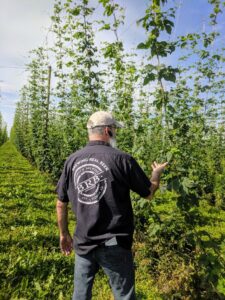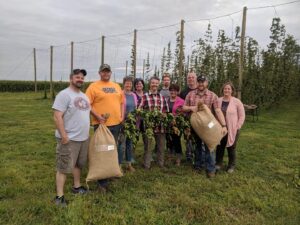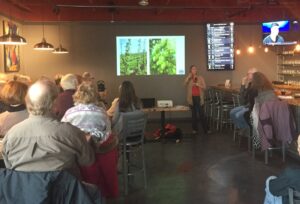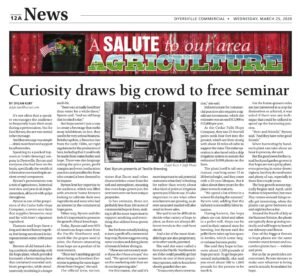Final report for FNC19-1158
Project Information
I started Cedar Falls Hops Co. in the spring of 2017 with my father, Rusty Leymaster, as my partner. We now have 7 acres of hops in production consisting of nearly 8,000 plants representing five varieties. Our family farm consists of 350 acres and the decision to begin growing hops was based on my background in horticulture and my father’s experience as a farmer.
In 2017 my husband and I moved back to the family farm that I was raised on to start our own family and continue farming. Until this time I was living in Florida and working as a horticulturist for the previous 12 years. I decided that growing hops was a good use of my specialized skills in horticulture. It was at this time that my father retired from his non-farming business and we looked at this partnership as a great way to utilize my father’s 42-year background in farming and my talents.
We have been surprised to learn how difficult marketing hops is and how much effort is used on this part of our operation. For every hour spent in cultivation there is a matching hour spent in marketing efforts. This sentiment has been echoed many times by other growers we have spoken with and shows the need for this project.
Historically, hops are not a new crop to the Midwest, though recently they have (re) emerged as a crop with much potential for growers. Yet the marketing and sales of hops has proven to be challenging for many farmers. Naively, many new growers start farming hops with the belief that if they can grow it then their local brewery will automatically purchase their harvest, only to find that marketing is as challenging as growing.
Being able to directly market hops to homebrewers will benefit growers, consumers and the community. Consumers will have access to a very fresh, high quality product that has unique flavors to the region in which it is grown. Farmers will be able to increase their profits and provide additional income to their communities.
This project will examine the best way to package, promote and market hops to consumers.
- Identify the best methods for marketing and packaging small quantity sales of hops (less than 3 pounds).
- Evaluate return on investment of various marketing efforts in increasing sales.
- Evaluate costs and profit of direct marketing of hops versus selling to a distributor.
- Share findings to other growers through field days, website and social media, as well as conference presentations.
Research
To evaluate the effectiveness of marketing to homebrewers the different methods of trying to reach this audience will be tracked. While many farmers are good at growing crops, hops require a different type of marketing methodology because there are rarely standard farmer’s cooperatives (co-ops) to sell harvests to for an average price. To bring fresh eyes and a new perspective to this I will work with a marketing consultant to evaluate new channels to reach customers and find improvements on our existing marketing efforts.
In initial research for this proposal, the following main channels will be used and evaluated:
- Direct sales through farm website. This part of the project will focus on website optimization and search engine optimization.
- Social media presence. This will include Facebook, Twitter, and Instagram.
- Outreach through in-person events. Specifically this will include the Des Moines Farmer’s Market, the IBEST brewer’s conference and Learn to Brew day events.
- Advertising in traditional print media outlets.
- Open house and field days.
All of these avenues seem to be reasonable ways for farmers to market their hops, however, doing all of these will be a major undertaking. By running these simultaneously over one season we will be able to compare and see which methods are worth the effort and costs.
Results of the different marketing methods were measured based on sales recorded. For in-person events and online marketing functions specific codes were created to track these sales on www.CedarFallsHops.com.
In-Person Events
While the conditions of covid-19 may have slightly altered our in-person marketing events I feel confident in their results. These consisted of giving presentations about growing hops in various counties around Iowa as well as creating a display sales booth at the Des Moines Farmers Market. The resulting sales of the 2-day market event were $168 in sales. The cost to have this was $90 registration cost plus the time spent over the two days.
Presentations to county groups were very popular and well attended, but had very low sales. Well over 240 people attended these presentations yet less than $40 in sales was generated. While sales were low, the reputations of our products and interest in Midwest grown hops was high and shows potential.
In November we had a booth at the Iowa Brewer's Guild annual conference, I-BEST. This two day event was attended by brewers from around Iowa. It was a good opportunity to meet brewers and learn about their operations but did not directly result in any sales.
Online Marketing
I found that money spent on SEM (Search Engine Marketing) did not seem well spent. It doesn’t help us to rate higher in Google if these folks are not then purchasing our product. Even though we did see an increase in website visits, the overall sales generated were less than $100 during the time that we were spending $500 per month on promotions.
During this time we also spent $500 per month on social media advertising. It seems that funds spent on social media (primarily Facebook) helped to increase ‘Likes’ and engagement with our page but did not greatly increase sales and less than $100 in direct sales were generated.
Our banner ads on the www.homebrewersassociation.org site proved to be the most rewarding, however did not cover the cost of the advertisement itself. The cost for this advertisement for one month was $710, the clickable advertisement has generated $214 in sales.
Print Advertising
Our print advertising in Zymurgy magazine, produced by the American Homebrewers Association, did not result in any sales. This cost $510 to run and no sales using the code on this advertisement were used for purchases.
Its hard to say what the best way to reach the homebrewing audience is for small growers. It may be a combination of in-person events and online advertising, specific to this audience, are the most impactful. I hope that the work we have done generates interest in the long term and helps to bolster sales after our advertising dollars have been spent.
Educational & Outreach Activities
Participation Summary:
 During the month of August several tours of Cedar Falls Hops Co. were led with the goal of introducing the professional brewing community, home brewing audience, and the public to the growing field of Midwest grown hops.
During the month of August several tours of Cedar Falls Hops Co. were led with the goal of introducing the professional brewing community, home brewing audience, and the public to the growing field of Midwest grown hops.
Tours were given to four breweries with time taken to specifically discuss the qualities specific to hops grown in this region (i.e. terroir). Invitations were sent to more than twenty breweries via email in mid-July and followed up with later in the season as well.
An open house type of tour was held in partnership with a local brewery, SingleSpeed Brewing, to introduce hops as an agricultural crop to the public. This event was published in the local newspaper as well as promoted via social media. It was extremely well attended with more than 40 people spending their Saturday morning on our farm.
The CRAZE local homebrew club held their August meeting at our farm. This event included a tour and hop sampling as well as discussion about how to use these in brewing. 
"Hop School" was held at SingleSpeed brewing as a classroom-type activity. Participants learned about the process of growing hops and then learned about how the final product was used in the brewing process.
Our winter season of 2019-2020 was very busy reaching out and speaking to different groups around the state of Iowa. We received a very warm welcome and generated a lot of press coverage at these presentations. In five presentations more than 240 people attended to learn about Iowa grown hops.
Here is a link a tv story on the presentation: https://www.kimt.com/content/news/Farmers-considering-growing-popular-beer-ingredient-in-Iowa-568032491.html
In the spring of 2020 the COVID pandemic caused our plans for in-person events to change. During this time we focused our efforts on marketing including social media, printed magazines and online websites focused on homebrewers.
Our goal for this project was to produce 4-5 social media posts per week across the platforms of Facebook, Instagram and Twitter. We began to utilize the website "Later.com" to schedule posts in advance and help batch this very time consuming work. By scheduling posts out for 1-2 weeks at a time we were able to better plan out our content and consistently engage with our audience.

Learning Outcomes
Marketing hops continues to be a challenge. The challenges of creating an "online presence" are outside the skill set often presented for farming hops. These new skills of learning web design, e-commerce and shipping fulfillment are not insurmountable, but certainly need to be taken into account when marketing to a home-based audience is the goal.
The continued push to give presentations and reach out to the community helps to build our reputation but has yet to result in many sales. It seems that these presentations are a good way to get introduced to the homebrewing community, and will help to build the reputation of the industry. We had more than 240 people attend programs during the winter of 2019-2020 and were warmly received at each presentation. I think that these presentations were an excellent way to reach homebrewers but most were not interested in purchasing, but rather just in learning more to grow their own hops.
I think this has helped to increase the visibility of our farm and we are now considered the experts at growing hops in Iowa. It is my belief that the time spent advising and helping answer questions will result in more sales in the future.
I found that money spent on SEM (Search Engine Marketing) did not seem well spent. It doesn't help us to rate higher in Google if these folks are not then purchasing our product. Even though we did see an increase in website visits, the overall sales generated were less than $100 during the time that we were spending $500 per month on promotions.
It seems that funds spent on social media (primarily Facebook) helped to increase 'Likes' and engagement with our page but did not greatly increase sales. It seems that there is a lot of emphasis on the number of followers a page has but if these folks aren't buying your products then it really doesn't matter.
Our print advertising in Zymurgy magazine, produced by the American Homebrewers Association, did not result in any sales.
Our banner ads on the www.homebrewersassociation.org site proved to be the most rewarding, however did not cover the cost of the advertisement itself. The cost for this advertisement for one month was $710, the clickable advertisement has generated $214 in sales.
Project Outcomes
For the first part of the this project of this project we were able to complete the SEM (Search Engine Marketing) component that included choosing keywords and geographies to focus online advertisements. While we did see an uptick in website visitation, from 75 visits per month to 400 per month, these visits did not necessarily result in online sales. The online codes created to track these, as well as analytic features, showed that there is a very small return on investment in these funds.
The printed advertising did not result in any sales and it is our thought that because it requires a person to then go to a website to purchase the use of an online "clickable" advertisement produced better results. Even though the online "banner ads" were considered better, they still did not generate enough revenue to pay for themselves (see the upper right hand corner of this screen shot).
The social media advertising seemed to be going well as we attracted many new followers and likes on Facebook, however the increased engagement did not result in increased sales. We utilized new scheduling programs to help make consistent posts and messaging but even with the increased activity we did not see revenue increases. It is a difficult part of the necessity of social media to stay active but also balance time when you realize it may not actually increase profits.

